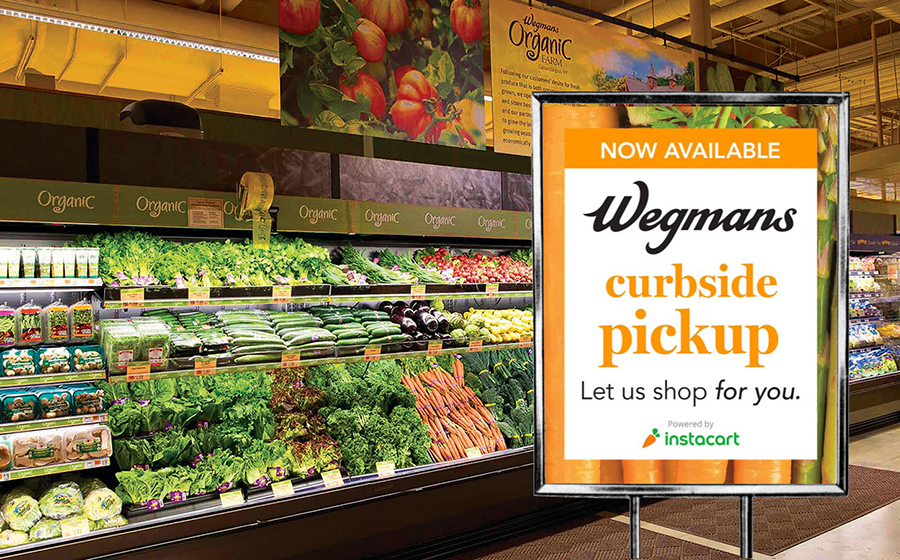The dam has burst. It\’s now evident that there\’s no stopping the proliferation of curbside pickup points being rolled out by food retailers. The most compelling indication of that came a short time ago when Wegmans supermarkets, at last, gave in and started a pilot program of curbside pickup points for its shoppers. Wegmans was perhaps the final significant holdout when it comes to using curbside pickup and the least likely to acquiesce given that pickup points are precisely antithetical to Wegmans\’ operating philosophy. We\’ll see more about that later, but first a brief primer on curbside pickup points and why they have some appeal for food retailers and some utility for many, but not all, shoppers.
- Pickup points, often referred to as \”PUPs\” in the industry, are simply numbered parking spots outside a retailer\’s store. Shoppers place a grocery order online and select an available time to arrive at the store. Shoppers pull into a predesignated parking spot and announce their presence on the store\’s app. Store personnel bring out the shopper\’s order and load it into the car. There is generally no fee or tip required.
- The benefit to the retailer, while not unmitigated, is that certain delivery costs are trimmed to something approaching nothing. Pickup orders are fulfilled without the complexity and cost of delivery vehicles and drivers.
Shoppers\’ Mixed Views
Many shoppers appreciate the convenience of the PUP solution, especially if they have young children to avoid the inconvenience of unloading them from the car, putting them into a stroller and pushing them all around a shopping venue. Shoppers also experience precision buying because if they order from home they can check their pantries and refrigerators to avoid duplicates or over buying. Assuming that the grocery pickup can be combined with other errands, it becomes a time-efficient proposition.
Conversely, many shoppers complain that the total process of ordering, driving to the store and waiting for the order to be put into the car takes longer than a trip into the store would have taken in the first place. Also, some prefer to select their own produce and choose favorable expiration dates on other products. Perhaps a more comprehensive online listing will ameliorate the expiration issue; selecting fresh produce is problematic. At least for the moment.
As to the downsides for retailers, those using the PUP system miss out on impulse buys and the experience of shopping. This is especially true for Wegmans, which has long been successful by showing in-store shoppers a wide variety of unique product and a very active food-preparation area with busy workers making restaurant-quality meals and much more. Indeed, many Wegmans stores have sit-down areas where shoppers can consume store-prepared meals functioning as the local restaurant. Wegmans is a destination – for many reasons.
Why Wegmans Held Out
That\’s why Wegmans held out for as long as possible against the PUP trend. But now there are more than 20 PUPs at Wegmans stores in and near its home town of Rochester, NY. Most likely, if they succeed they will appear throughout its network of about 100 stores along the Atlantic seaboard.
Wegmans is not alone in its reticence about PUPs. For years, supermarket retailers have tried them, discontinued them and then tried again. In recent time, though, the dam has burst and they\’re appearing everywhere, probably because of advances in smartphone technology and customer demand. A short list of stores with PUPs includes selected locations at Walmart, Kroger, Target, Whole Foods, Publix, Ahold, Albertsons, Meijer and countless regional operators.
It seems food retailers have collectively acknowledged that many of their shoppers view grocery shopping as a chore and not an experiential event they want frequently. As is often the case, time pressures on consumers trump the benefit of physically doing, seeing and sharing things.
Clearly, competitive pressures have driven Wegmans and numerous other food retailers into the arms of PUPs, just as Wegmans and many other food retailers were obliged to start delivery services, often by way of a contract provider. Finally, it\’s obvious that all the downsides described by consumers and retailers concerning PUPs pertain as much or more to direct-to-consumer delivery services. That explains why food retailing lags many other retailing forms in utilizing delivery and the tech infrastructure that enables online services.
It\’s perhaps instructive to note that Trader Joe\’s, another retailer that trades on the in-store experience, in recent weeks abandoned delivery altogether after a long but small experiment. For 10 years, Trader Joe\’s offered delivery in Manhattan, but nowhere else, and of course never used PUPs based on the city\’s unique urban locations. It now intends to never again offer delivery, saying the cost of delivery was \”unsustainable\” and would lead to counterproductive price-point increases. Regardless of the trading style you prefer, it\’s heartening to see a store chain make such a commitment to physical store-based retailing. Now, even Amazon is moving in that direction.




